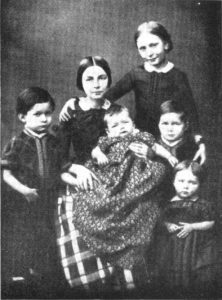The song cycles of Schumann and Britten share a longing for innocence, an adult’s attempt at regaining childishness. One and the other reflect the myth of the first stage in a person’s life as a path of no return, lamented like some paradise lost. After the outstanding success of Ian Bostridge in Katowice:
***
For the child to exist, it had to be invented. Before childhood began to be regarded as a separate stage in human life, many languages did not even have a word to define this curious miniature person. That does not mean to say that no one was concerned with children or that their biological needs were widely neglected. Yet a kind of preselection was made, depending on various factors: social, economic and even political. A child could be put to death, abandoned or excluded. It could be separated from its mother in the same way that six-month-old foals are taken from suckling mares. The dawn of an emotional approach to little human beings was marked by fear: those delicate creatures of God required not only care, but conversion. They were as weak, mindless and primitive as cattle. They stirred no more emotion in observers than trained monkeys. They were often mere playthings in adult hands. They were accompanied everywhere, ate what their carers ate, slept with them and observed their sexual activities, and matured through work.
In the eighteenth century, they gained autonomy. It was a peculiar autonomy at first: adults began to look at children as if in a mirror, perceiving in the little ones their own lost innocence, treating childhood as a prefiguration of adult life, with all its ups and downs, and regarding a child as a being suspended between two worlds, a metaphor of infinity, a bridge to God and heaven.
Clara Schumann and her children (1853).
The first attempt to create an international system for the protection of children’s rights only came in the early twentieth century. In 1924, the General Assembly of the League of Nations adopted the Geneva Declaration, the most crucial postulate of which read that ‘the child that is hungry must be fed, the child that is sick must be nursed, the child that is backward must be helped, the delinquent child must be reclaimed, and the orphan and the waif must be sheltered and succoured’. The myth of a romantic childhood, derived from the ideas of Rousseau, dominated throughout the nineteenth century, and in some people’s awareness it lasts still today: the image of the first stage in human life as a trail of contradictions, a path of no return, often marked by suffering, yet lamented like a lost paradise.
The song cycles by Schumann and Britten share this longing for innocence, adults’ attempts at regaining their childishness. None of these songs is suitable for performance by a child: at most, one might sing it to a child, but only a mature listener will penetrate its deeper layers of meaning. Schumann wrote his Liederalbum für die Jugend, Op. 79 in 1849, when he already had behind him a long history of depression, the grave illness of his third daughter and the death of his eagerly awaited first son. This cycle – although peopled by numerous figures from a child’s imagination – is too long for a child’s perception; at times, it even seems too exhausting for an adult singer. Meanwhile, the Five Songs to Words by Andersen (in loose translations by Adelbert von Chamisso), Op. 40, composed ten years earlier, in the year of his wedding with Clara Wieck, come across rather as a homage to his young wife’s lost childhood. Schumann fell in love with Clara when she was just twelve, and for the next ten years or so he struggled to win consent for their marriage from her father, who was interested mainly in his daughter’s career as a pianist. That may explain why the piano is more prominent in this composition, and it is the instrument – not the words – that articulate the ‘childishness’ in the poetry: the musical equivalent of the creaking of a cradle, a boy’s marching like a soldier, someone crying over a first betrayed love. A similar idea appears to have informed the cycle of piano miniatures entitled Kinderszenen (1838) – these are not ‘easy pieces’ for children, but tales from a child’s room, told in songs without words.
Edith Britten and her children (1915).
Britten treated his text completely differently. Both in Winter Words (1953), to poetry by Thomas Hardy, and in the cycle Who Are These Children? (1969), composed to verse by the Scottish poet William Soutar, he assumes the role of translator rather than interpreter. If he does interfere in the verbal material, he does so like Janáček, employing deliberate repetition, reinforcing the expression of the message. The first cycle is a melancholy, thoroughly Romantic journey from the state of childish naivety to the bitter self-awareness of old age. The second is a modernist trip around the by-ways of life, from childishness told in Scottish dialect to a sad adulthood of polished English and back again – the story of an outcast torn between the innocence of a boy and the hard-heartedness of a grown man.
In Britten’s songs, we begin to observe a significant crack in our relationship with the idea of childhood – a breach that has accompanied us to this day. It is the sense that the child has been forcefully banished from the world of adults, enclosed by our overprotectiveness in a safe haven, from which it will one day emerge unprepared for the cruelty of adulthood. We should be thankful that at least composers try to fill that chasm of misunderstanding.
Translated by: John Comber


